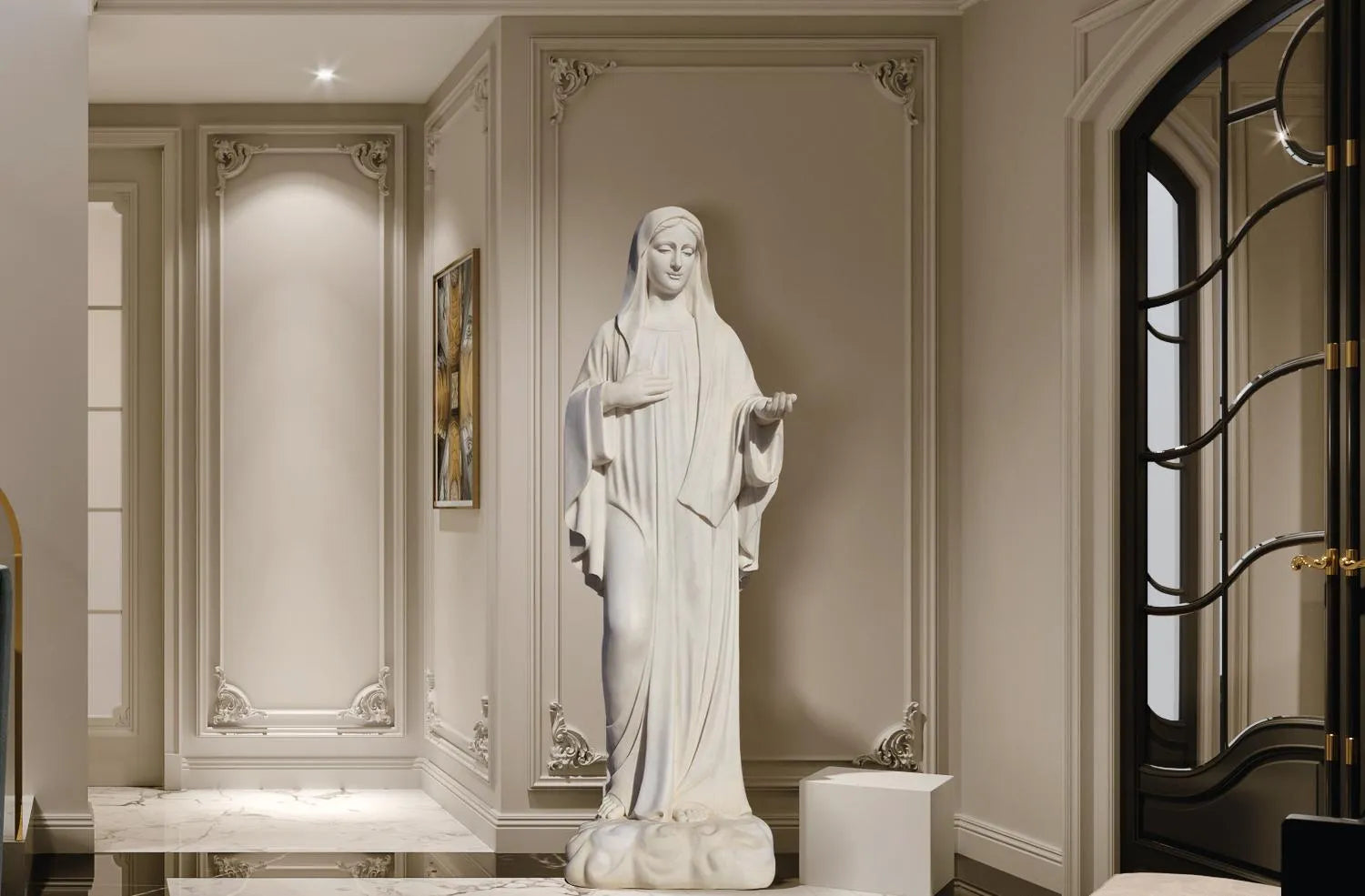Sculptures are like silent storytellers that bridge time and culture. They stand in cities, museums, and natural landscapes, carrying the wisdom, emotions, and creativity of different eras. From ancient civilizations to modern times, countless sculptures have become symbols of human history. Let’s take a journey to discover some of the most famous sculptures around the globe and learn about their stories.
1. The Statue of Liberty (USA)
Perhaps one of the most recognizable sculptures in the world, the Statue of Liberty stands tall in New York Harbor, USA. Designed by French sculptor Frédéric Auguste Bartholdi and completed in 1886, this massive copper statue was a gift from France to the United States to celebrate the 100th anniversary of American independence.

The statue depicts a woman holding a torch of freedom in her right hand and a tablet inscribed with "July 4, 1776" (the date of the U.S. Declaration of Independence) in her left. Her crown has seven spikes, representing the seven continents and seven seas, symbolizing freedom spreading across the world. Standing at over 93 meters tall (including the pedestal), it was the tallest metal structure in the world when first built.
For millions of immigrants arriving in the U.S., the Statue of Liberty was the first sign of hope, symbolizing a new life and opportunities. Today, it remains an iconic symbol of freedom, democracy, and the American Dream.
2. David (Italy)
In Florence, Italy, Michelangelo’s David is a masterpiece of the Renaissance. Created between 1501 and 1504, this marble sculpture stands about 5.17 meters tall and depicts the biblical hero David before his battle with the giant Goliath.
What makes David sculpture remarkable is its incredible detail and realism. Michelangelo perfectly captured David’s tense muscles and focused expression, showing both physical strength and mental determination. The veins in his hands, the texture of his hair, and the slight turn of his head all reveal the artist’s deep understanding of human anatomy.
Originally placed in the Piazza della Signoria, David is now displayed in the Galleria dell’Accademia in Florence. It represents the spirit of humanism—celebrating human potential, beauty, and individuality—and is considered one of the greatest sculptures ever made.
3.The Thinker (France)
Auguste Rodin’s The Thinker is a symbol of philosophical reflection. Created in the late 19th century, this bronze Thinker sculpture shows a man sitting on a rock, resting his chin on his hand, deep in thought. Originally part of Rodin’s larger work The Gates of Hell (inspired by Dante’s Inferno), The Thinker was meant to represent Dante contemplating the pains of hell.

The sculpture’s powerful physique and hunched posture convey a sense of inner struggle and deep thinking. Rodin used rough, uneven surfaces on the bronze to create a contrast between light and shadow, adding depth to the figure’s emotions. Over time, The Thinker has become an icon for anyone engaged in serious thought, whether in philosophy, art, or daily life.
You can find versions of The Thinker in many cities, including the Rodin Museum in Paris and the garden of the Philadelphia Museum of Art in the U.S.
4. Moai (Easter Island, Chile)
The Moai statues on Easter Island are a mystery of ancient civilization. These massive stone figures were created by the Rapa Nui people between 1250 and 1500 CE. There are about 900 Moai on the island, with the largest standing over 10 meters tall and weighing up to 82 tons.
Carved from volcanic rock, the Moai have large heads, long faces, prominent brows, and straight noses. Most of them stand on stone platforms called ahu, facing inland as if watching over the island’s villages. Researchers believe they represent ancestral chiefs or gods, symbolizing power and connection to the spiritual world.
What’s fascinating is how the Rapa Nui people transported these heavy statues from the quarry to their final locations without modern machinery. The Moai are now a UNESCO World Heritage Site, attracting visitors who wonder about the island’s ancient culture and the reasons behind its decline.

5.Terracotta Army (China)
In Xi’an, China, the Terracotta Army is a breathtaking archaeological discovery. Built around 221–206 BCE for Emperor Qin Shi Huang, the first emperor of China, this army of over 8,000 life-sized terracotta soldiers, horses, and chariots was created to protect the emperor in the afterlife.
Each soldier has a unique face, hairstyle, and uniform, showing different ranks and roles. Some hold weapons, while others stand in formation, ready for battle. The detail is astonishing—even the soles of their shoes have distinct patterns. The army was buried with the emperor in a massive tomb complex, hidden for over 2,000 years until farmers accidentally discovered it in 1974.
The Terracotta Army provides valuable insights into ancient Chinese military, art, and technology. It’s a testament to the power and ambition of Emperor Qin Shi Huang, who unified China and aimed to control both the living world and the afterlife.

6.Christ the Redeemer (Brazil)
Overlooking Rio de Janeiro, Brazil, Christ the Redeemer is a symbol of faith and peace. Completed in 1931, this 30-meter-tall statue of Jesus Christ stands on the summit of Corcovado Mountain, with its arms outstretched as if embracing the city.
Designed by French sculptor Paul Landowski and built by Brazilian engineer Heitor da Silva Costa, the statue is made of soapstone and reinforced concrete. It took nine years to construct and has become one of the most iconic landmarks in South America. On clear days, the statue can be seen from miles away, symbolizing hope and unity for millions of people.
Christ the Redeemer is not only a religious symbol but also a UNESCO World Heritage Site. It attracts tourists and pilgrims alike, offering breathtaking views of Rio de Janeiro and a sense of spiritual calm.
7.The Little Mermaid (Denmark)
In Copenhagen, Denmark, a small bronze statue sits by the waterfront, known as The Little Mermaid. Unveiled in 1913, this 1.25-meter-tall sculpture is based on Hans Christian Andersen’s famous fairy tale about a mermaid who gives up her voice to become human.
The statue shows the mermaid sitting on a rock, looking longingly towards the shore. Her delicate features and quiet pose capture the story’s themes of love, sacrifice, and longing. Although small in size, it has become a symbol of Copenhagen and a popular spot for visitors.
Interestingly, the statue has been the target of several pranks over the years, such as having its head or arm stolen, but it always gets restored, showing the city’s love for this iconic figure.
8. Venus de Milo (France, Louvre Museum)
The Venus de Milo is an ancient Greek sculpture now housed in the Louvre Museum in Paris, France. Created around 130–110 BCE, this marble statue represents Aphrodite, the goddess of love and beauty. It’s famous for its missing arms, which have sparked endless speculation about their original pose.
Despite the damage, the Venus sculpture’s grace and beauty remain striking. The goddess stands with a slight S-curve, her drapery flowing naturally over her body, creating a sense of movement and life. The Venus de Milo embodies the ancient Greek ideal of beauty—harmony, balance, and perfection—and has influenced art for centuries.
Discovered on the Greek island of Milos in 1820, the statue quickly became a symbol of classical art. Its timeless elegance continues to inspire artists and visitors alike.
9.Niki de Saint Phalle’s Nanas (Worldwide)
In contrast to ancient and classical sculptures, Niki de Saint Phalle’s Nanas bring a burst of color and modern energy. Created by the French-American artist in the 1960s, these large, cheerful figures celebrate female power and diversity.

Nanas are bold, curvaceous women with bright colors, patterns, and playful expressions. Saint Phalle wanted to challenge traditional beauty standards and highlight the joy of femininity. Made from materials like fiberglass and polyester resin, the Nanas can be found in cities around the world, from Paris to Tokyo, adding a sense of fun and freedom to public spaces.
Each Nana is unique, with different hairstyles, outfits, and poses, reflecting the artist’s belief in individuality and empowerment. They are a lively reminder of the importance of celebrating women in art and society.
10.The Bean (USA)
In Chicago, USA, a modern sculpture called Cloud Gate, nicknamed “The Bean,” has become a beloved landmark. Designed by Indian-born British artist Anish Kapoor and unveiled in 2006, this stainless steel sculpture is shaped like a giant bean, with a smooth, mirrored surface that reflects the city’s skyline and visitors.
Standing 10 meters tall, Cloud Gate is a masterpiece of modern art. Its curved shape creates interesting reflections and distortions, making it a popular spot for photos. People love to walk under it, touch its shiny surface, and see their own images stretched and twisted in fun ways.

Located in Millennium Park, the sculpture has transformed the area into a gathering place for both locals and tourists. It shows how modern art can connect with people in simple, joyful ways.
Why Sculptures Matter
From ancient Moai to modern Nanas, sculptures tell us about who we are and where we come from. They preserve history, express emotions, and spark imagination. Whether standing in a busy city square or a quiet museum, they invite us to pause, look closer, and think about the world around us.
Next time you see a sculpture, take a moment to wonder: What story is it telling? What did the artist want to share? You might be surprised by the connections you find between the past, present, and the creative human spirit.
This journey through famous sculptures shows the diversity of human artistry. If you want to customize your own sculpture, Contact us today to discuss your sculpture needs and get a personalized free quote.












